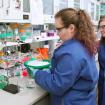Ai-Ling Lin Featured on LabTV
Ai-Ling Lin is the principal investigator in her own lab in the Sanders-Brown Center on Aging and an assistant professor in pharmacology and nutritional sciences at the University of Kentucky.
A native of Taiwan, Lin decided to pursue science in junior high. “I was inspired by Isaac Newton and Albert Einstein, because I was so fascinated by how they could use simple equations to describe how things work and the beauty of the universe,” she says.
Lin came to UK because of the opportunity to do translational neuroimaging research and the strength of the Sanders-Brown Center on Aging funded by the National Institute on Aging.
“I don’t want just do animal work. I want to translate all these findings into human clinical trials and to make real impact in patients and in healthcare. So UK is excellent environment for me to do this,” says Lin.
“This lab, this team, is just like a family and we care for one another, but at the same time we learn from each other.”
The team’s goal is to identify effective interventions to slow down brain aging and prevent dementia. “We’re using rapamycin, an FDA-approved drug that can extend longevity and also reduce neuropathology. And we use different levels of nutritional intervention to see how diet can impact our cognition. We using imaging to identify the treatment efficacy of these two interventions, and do behavior testing to see how this impacts animal memory and learning ability and hope one day we can translate this to humans.”
Lin and her lab team, including Rachel Armstrong and Jared Hoffman, are featured on LabTV.com. This website features videos with medical researchers who tell where they came from, how they chose their career, what they do each day in the lab, and why they love it. LabTV’s founder, Jay Walker of TEDMED, said he started the site because if high school students can personally identify with a young medical researcher, they are far more likely to consider becoming one. LabTV’s network features researchers working at leading universities, corporations, and the National Institutes of Health.


